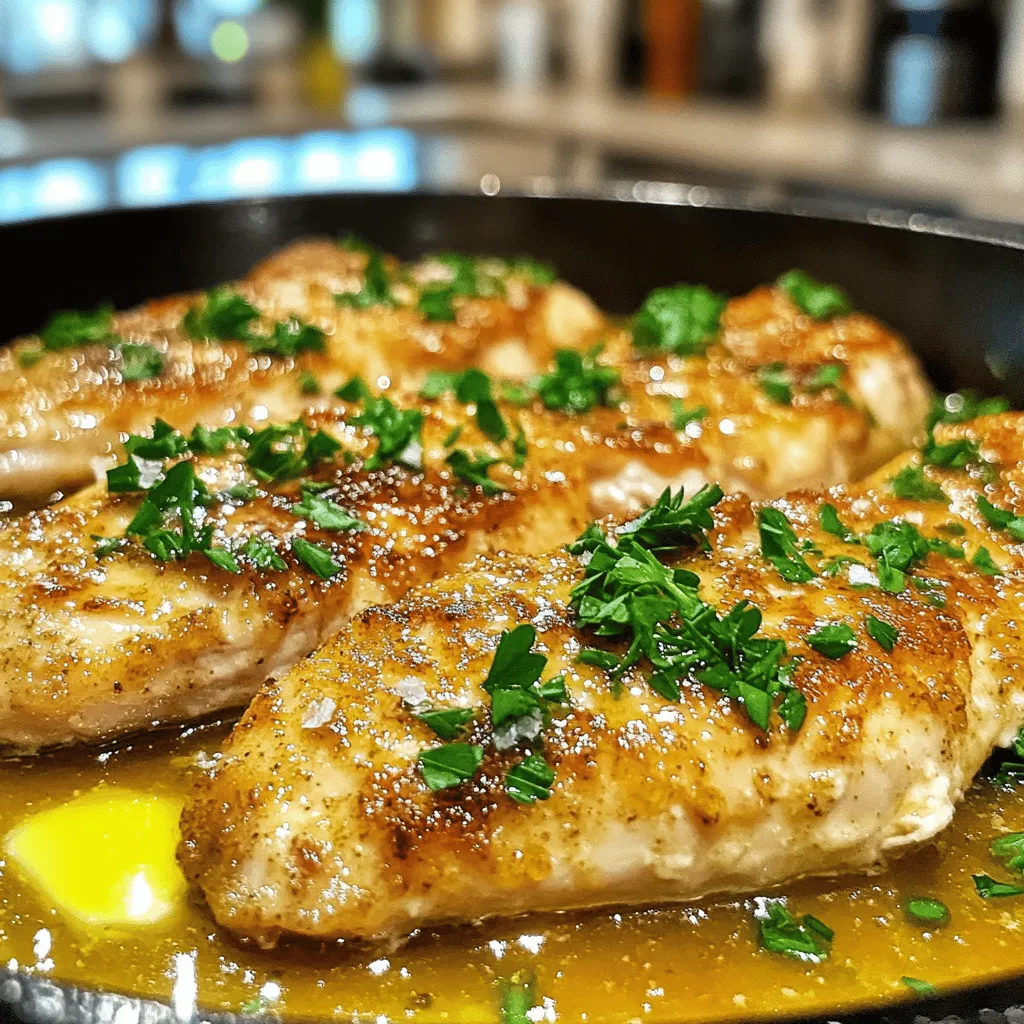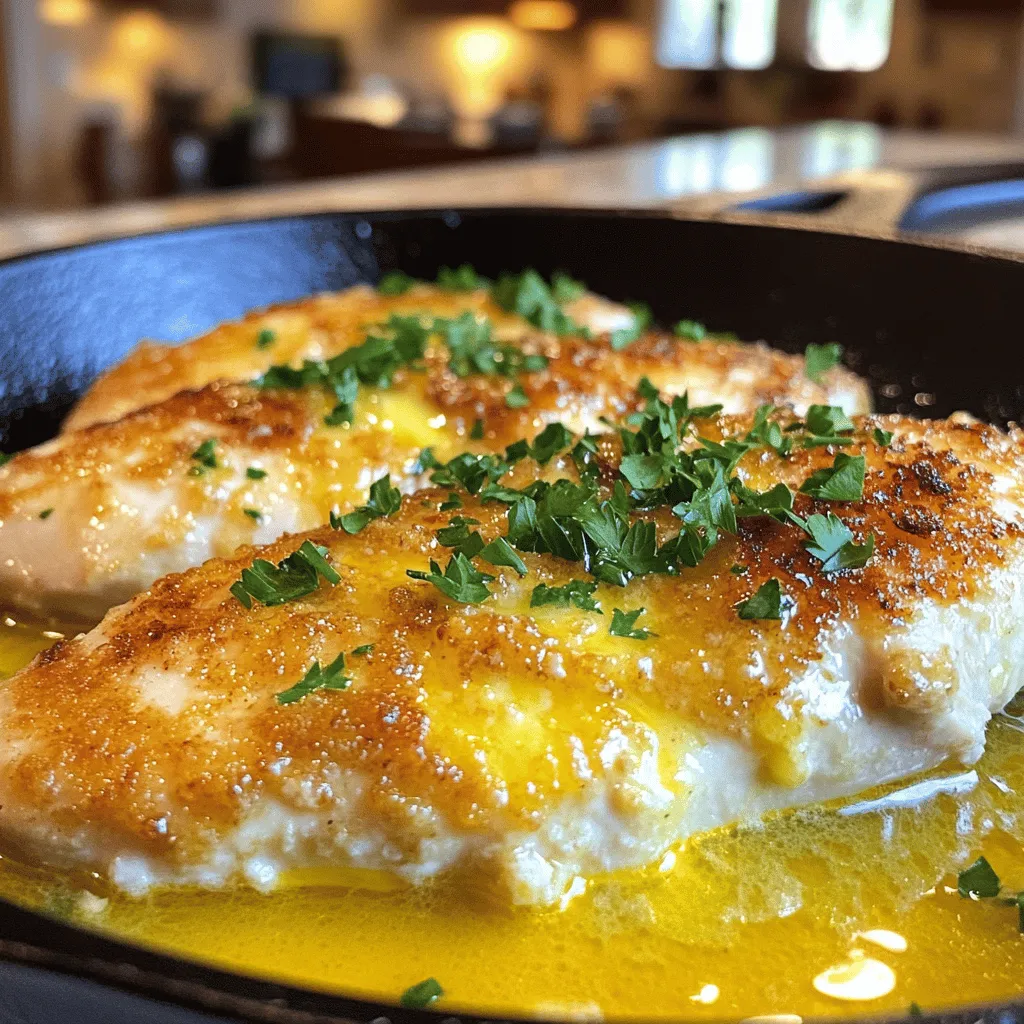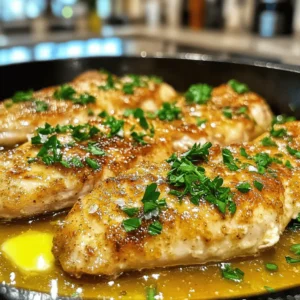Are you ready to impress everyone at dinner? Today, I’ll show you how to make melt-in-your-mouth chicken breasts. With just a few simple ingredients, you can create tender, juicy chicken that steals the show. Whether you’re new to cooking or a seasoned pro, my step-by-step guide will set you up for success. Let’s dive into the secrets that will make every bite unforgettable!

Ingredients
Essential Ingredients for Melt-In-Your-Mouth Chicken Breasts
To make melt-in-your-mouth chicken breasts, you need a few key items. These ingredients work together to create juicy and flavorful chicken.
– 4 boneless, skinless chicken breasts
– 1 cup buttermilk
– 1 tablespoon garlic powder
– 1 tablespoon onion powder
– 1 teaspoon smoked paprika
– 1 teaspoon salt
– 1/2 teaspoon black pepper
– 1 cup all-purpose flour
– 1/4 cup cornstarch
– 1 tablespoon fresh parsley, finely chopped (for garnish)
– 1/4 cup unsalted butter
– 2 tablespoons olive oil
Common Substitutions for Ingredients
If you can’t find some ingredients, no worries! Here are some easy swaps:
– Buttermilk: Use regular milk with a splash of vinegar or lemon juice.
– Garlic Powder: Fresh minced garlic works well too.
– Smoked Paprika: Try regular paprika for a milder taste.
– Unsalted Butter: You can use salted butter, but reduce the added salt.
– Cornstarch: All-purpose flour can replace cornstarch, but it may change the texture slightly.
Optional Garnishes to Enhance Flavor
Want to make your dish shine? Here are some fun garnishes to consider:
– Fresh herbs like thyme or basil for an aromatic touch.
– Lemon zest for a bright, citrusy flavor.
– A drizzle of honey or balsamic glaze for a sweet finish.
These ingredients and tips will help you create the best melt-in-your-mouth chicken breasts.Enjoy your cooking!
Step-by-Step Instructions
How to Marinate Chicken for Maximum Tenderness
To start, you need to marinate the chicken. This step makes the chicken tender and flavorful. In a large bowl, mix one cup of buttermilk, one tablespoon of garlic powder, one tablespoon of onion powder, one teaspoon of smoked paprika, one teaspoon of salt, and half a teaspoon of black pepper. Whisk this together well. Then, add the chicken breasts. Make sure they are fully covered by the marinade. Cover the bowl with plastic wrap. Let it sit in the fridge for at least one hour. For the best results, leave it overnight.
Preparing the Oven and Skillet for Cooking
Next, you’ll need to prepare your oven and skillet. Preheat your oven to 375°F (190°C). While the oven heats up, take a shallow dish or plate. In this dish, mix one cup of all-purpose flour and one-fourth cup of cornstarch. Stir them together well to ensure they blend evenly. This mix will help create a crispy coating on the chicken.
Detailed Coating and Searing Process
Once marinated, take the chicken out of the bowl. Let any extra marinade drip off. Now, dredge each chicken breast in the flour and cornstarch mixture. Press lightly to make sure the coating sticks well. In a large, oven-safe skillet, heat one-fourth cup of unsalted butter and two tablespoons of olive oil over medium-high heat. When the butter melts, add the coated chicken. Sear each breast for about four to five minutes on each side. Look for a golden-brown crust to form.
Baking for Perfectly Cooked Chicken
After searing, it’s time to bake! Carefully transfer the skillet to your preheated oven. Bake the chicken for 20 to 25 minutes. Use a meat thermometer to check the internal temperature. It should reach 165°F (75°C). This ensures the chicken is fully cooked and safe to eat.
Tips & Tricks
How to Ensure Juicy Chicken Breasts
To get juicy chicken breasts, start with marination. The buttermilk in the marinade works wonders. It adds moisture and tenderizes the meat. Marinate for at least one hour, but overnight is best. This gives the flavors time to soak into the chicken. Also, do not rush the cooking. Searing and baking should be done at the right temperatures. Use a meat thermometer to check for doneness. Aim for 165°F (75°C) for safety and juiciness.
Best Practices for Marinating
When marinating, always use a non-metal bowl. Metal can react with the acids in the marinade. Mix your buttermilk and spices well so every piece of chicken gets flavor. Make sure the chicken is fully covered in the marinade. If needed, flip it halfway through. This helps to ensure even flavor and tenderness. For a twist, try adding citrus zest or herbs to the mix. These add depth and freshness to the chicken.
Troubleshooting Common Problems
If your chicken turns out dry, it may have been overcooked. Always check your chicken’s temperature early. If the crust is too dark but the inside is not done, reduce the heat. If you experience bland chicken, ensure your marinade has enough salt and spices. Taste it before adding the chicken. If you find your chicken lacks crunch, try pressing the coating onto the chicken more firmly. This helps it stick better during cooking.

Variations
Flavorful Additions to the Marinade
You can add many flavors to the marinade. Try mixing in some lemon juice or zest for a bright taste. Honey adds a nice sweetness that balances the spices. Fresh herbs like thyme or rosemary can bring a lovely aroma. If you like heat, a pinch of cayenne pepper or chili flakes can spice things up. For a smoky flavor, consider adding more smoked paprika or some liquid smoke. Each addition can change the dish, making it yours.
Cooking Method Alternatives (Grilling, Air Frying)
Grilling is a great way to cook these chicken breasts. It gives them a nice char and smoky flavor. Set your grill to medium-high heat. Cook the marinated chicken for about 6-8 minutes on each side. Keep an eye on the temperature. It should reach 165°F (75°C).
Air frying is another quick option. Preheat your air fryer to 375°F (190°C). Place the chicken in a single layer and cook for about 15-20 minutes. Check the internal temperature, just like with grilling. Both methods keep the chicken juicy and tender, while adding unique flavors.
Suggested Side Dishes for a Complete Meal
Pair your chicken with delicious sides to make it a full meal. Roasted vegetables like carrots and broccoli complement the chicken’s flavor. Mashed potatoes or creamy polenta also work well. A fresh green salad adds a nice crunch. You can even serve it with rice or quinoa for a hearty option. Each side can enhance your melt-in-your-mouth chicken breasts and create a balanced plate.
Storage Info
How to Store Leftover Chicken Breasts
To keep leftover chicken breasts fresh, let them cool first. Place the chicken in an airtight container. You can also wrap it tightly in plastic wrap or aluminum foil. Store the chicken in the fridge for up to three days. This way, it stays juicy and tasty for your next meal.
Reheating Instructions for Best Results
When reheating your chicken, aim for warmth without drying it out. Preheat your oven to 350°F (175°C). Place the chicken in an oven-safe dish and cover it with foil. Heat it for about 15-20 minutes. This keeps the chicken moist. You can also use a microwave, but be careful. Use a lower power setting, and heat it in short bursts. Check often to ensure it stays tender.
Freezing Tips for Meal Prep
If you want to freeze chicken, do it soon after cooking. Let the chicken cool down completely. Wrap each piece tightly in plastic wrap, then place them in a freezer bag. Remove as much air as possible. Label the bag with the date. Frozen chicken lasts up to three months. When ready to eat, thaw it in the fridge overnight for the best results. You can then reheat it according to the earlier instructions. This method helps maintain the chicken’s melt-in-your-mouth quality.
FAQs
What makes chicken breasts melt in your mouth?
The secret lies in the marinade. Buttermilk works wonders by breaking down proteins. This gives the chicken a tender texture. The garlic and onion powders add depth. Smoked paprika brings a warm, smoky flavor. Together, they create a juicy, flavorful experience.
Can I use bone-in chicken for this recipe?
Yes, you can use bone-in chicken. It may take longer to cook, though. Bone-in pieces can add flavor and moisture. Just make sure to check the internal temperature. It should reach 165°F (75°C) for safety.
How to know when the chicken is fully cooked?
Use a meat thermometer to check the chicken’s temperature. Insert it into the thickest part of the breast. It should read 165°F (75°C). This ensures the chicken is safe to eat. If you don’t have a thermometer, cut into the chicken. The juices should run clear, not pink.
How long can I marinate the chicken?
You can marinate the chicken for one hour to overnight. Longer marination gives better flavor and tenderness. However, avoid going over 24 hours. The chicken can become too soft and mushy.
What sides pair well with Melt-In-Your-Mouth Chicken Breasts?
Several sides complement this chicken perfectly. Roasted vegetables add color and nutrition. Mashed potatoes provide creaminess. A fresh salad offers a crisp contrast. Rice or quinoa can soak up the juices. Explore your favorites to create a balanced meal.
You now know the key to melt-in-your-mouth chicken breasts. We’ve covered essential ingredients, marination steps, and cooking methods. You learned how to keep chicken juicy and avoid common mistakes. Exploring variations adds excitement to your meals. Don’t forget to store extra chicken properly for future enjoyment.
With these tips, you can create delicious dishes every time. Trust this guide to make your cooking joyful and easy. Enjoy your kitchen adventures!

